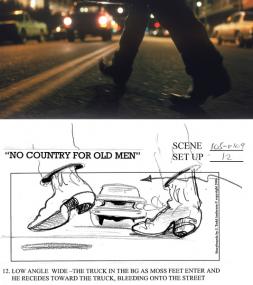Storyboarding with the Coen Brothers
 Wonderful article about the work of J. Todd Anderson, who storyboards the Coen Brothers’ movies:
Wonderful article about the work of J. Todd Anderson, who storyboards the Coen Brothers’ movies:
Anderson’s drawings have a jauntiness that seems absent from the more serious cinematic depiction; Anderson says he is simply trying to inject as much of a sense of action as possible into each scene.
Anderson describes the process of meeting about a new film:
“It’s like they’re making a movie in front of me,” he says. “They tell me the shots. I do fast and loose drawings on a clipboard with a Sharpie pen—one to three drawings to a sheet of regular bond paper. I try to establish the scale, trap the angle, ID the character, get the action.”
More in the article…

